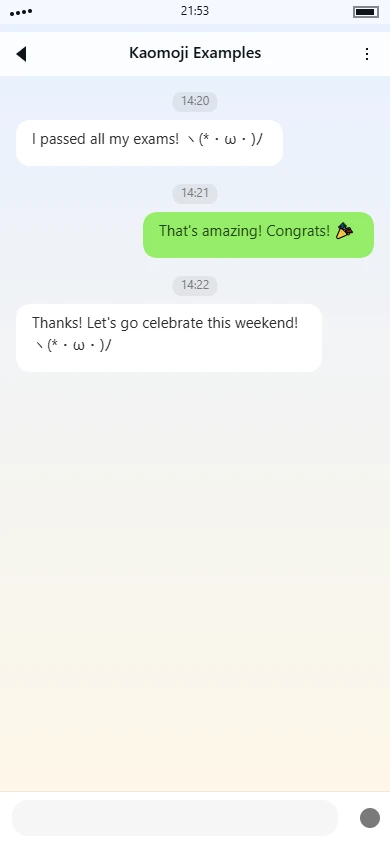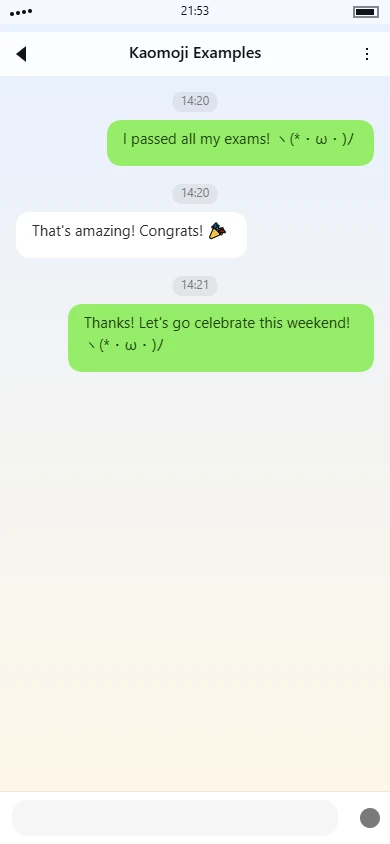(„• ֊ •„) kaomoji meaning | usage tips

Overview
The kaomoji
(„• ֊ •„)Symbol Breakdown
- Parentheses framing: The curved brackets
and(
create a soft facial outline, suggesting a rounded face shape without sharp edges) - Quotation mark eyes: The low-9 quotation marks
serve as the left eye, positioned lower than typical eye placements to create a downward or sideways glance effect„ - Central dot elements: The bullet points
function as blush marks or small decorative elements flanking the central mouth• - Armenian hyphen mouth: The
character acts as a small, subtle mouth, positioned centrally with minimal horizontal extension֊ - Asymmetrical spacing: The uneven spacing between elements contributes to the impression of a slightly tilted or averted head position
Emotion & Aesthetic Analysis
The emotional interpretation of this kaomoji leans toward shyness or mild embarrassment, with elements that suggest someone avoiding direct eye contact. The downward positioning of the quotation mark eyes creates a looking-away effect, while the central dot elements can be read as small blush marks on the cheeks. The overall composition avoids strong emotional declarations in favor of a more nuanced, subtle expression.
Compared to similar kaomoji, this version uses less common typographical characters to achieve its effect. The Armenian hyphen
֊„The kaomoji's emotional range includes shy appreciation, quiet embarrassment, or gentle awkwardness. It could be used in contexts where someone is modestly receiving praise, feeling slightly self-conscious, or expressing a tempered positive reaction. The expression avoids extreme emotions in favor of something more contained and nuanced, making it suitable for situations that call for emotional subtlety rather than dramatic declaration.
Tag categories
Use tags to quickly understand this kaomoji.
Usage guide
Usage Guide for („• ֊ •„)
The kaomoji („• ֊ •„) is a charming and versatile expression that captures a sense of playful shyness, gentle surprise, or quiet amusement. With its rounded eyes and subtle mouth shape, it conveys a range of soft emotions from bashful happiness to mild bewilderment. This emoticon is particularly popular in casual online conversations where users want to express feelings in a cute, non-confrontational way. It's often seen in friend chats, gaming communities, and social media comments where the tone is lighthearted and affectionate. The expression works well across various platforms including Discord, Twitter, and messaging apps, serving as a digital equivalent of a shy smile or a gentle nudge.
Common Use Cases
- When receiving an unexpected but pleasant compliment from a friend
- Reacting to a cute animal video that made you smile shyly
- Expressing gentle surprise when someone remembers a small detail about you
- Responding to a flirtatious message in a playful, non-committal way
- Showing quiet amusement at an inside joke within your friend group
- Reacting to someone's creative work that impressed you in a subtle way
- When you're feeling slightly embarrassed but in a positive, warm way
- Expressing mild confusion about a game mechanic while still maintaining a positive attitude
- Responding to food pictures that look almost too adorable to eat
- Showing gentle excitement about plans that are still in the early stages
- Reacting to romantic gestures that are sweet but make you feel a bit shy
- Expressing quiet contentment when someone includes you in their plans
Example Conversations
-
Friend: I saved you the last piece of cake!
You: („• ֊ •„) you remembered it's my favorite -
Partner: I was thinking we could watch that movie you mentioned last week
You: („• ֊ •„) you actually listened to my rambling about films -
Gaming buddy: I crafted this weapon for you since you kept dying in that dungeon
You: („• ֊ •„) that's so thoughtful of you -
Online friend: Your art style has improved so much since last month!
You: („• ֊ •„) thank you for noticing the small changes -
Family member: I made your favorite childhood dish for dinner tonight
You: („• ֊ •„) you still remember what I liked as a kid -
Colleague: I covered your shift so you could attend that concert
You: („• ֊ •„) that's incredibly kind of you
Important Notes
- Avoid using this kaomoji in formal workplace communications or serious discussions where clear, unambiguous language is required
- The expression carries a distinctly casual and affectionate tone, so it might be misinterpreted as flirtatious or overly familiar in professional contexts
- Be mindful that the shy/playful nature of this emoticon might not convey the appropriate level of seriousness in conversations about important matters
- In some cultural contexts, the bashful quality might be interpreted as uncertainty rather than positive shyness, so consider your audience carefully
- This kaomoji works best when you have an established friendly relationship with the recipient, as it relies on shared understanding of the playful tone
Usage examples
Real conversation samples that feature this kaomoji.

Example 1

Example 2
Related kaomoji
You might also enjoy these kaomoji.